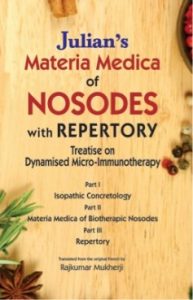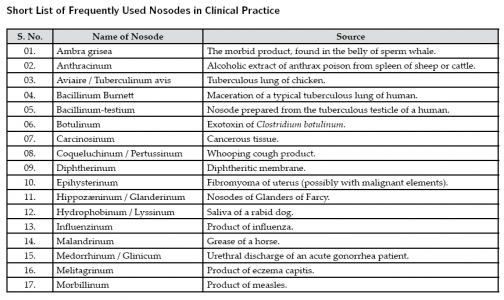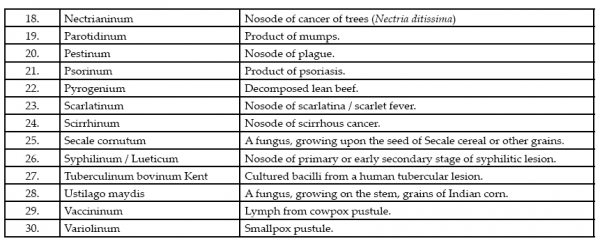 Nosodes
Nosodes
‘Application of an attenuated dose of a pathogenous product for curing
the disease of which it is the result, if it is used after having been experimented on healthy man, it becomes a NOSODE.’ – Dr. Pierre Schmidt A nosode [nosos (Greek) – means disease] is a homeopathic preparation made from matter from a sick animal or person. Substances such as respiratory discharges or diseased tissues are used. It sounds repulsive, but the preparation, using alcohol, as well as the repeated dilutions and succussions, essentially renders the substances harmless, while producing a powerful remedy. The use of nosodes in a prophylactic manner for preventing disease, has been employed in veterinary and human homeopathy for many years. It is supported by various holistic veterinarians and authors.
According to HPI (Vol. IV), nosodes is the ‘homeopathic preparation from pure microbial culture obtained from disease tissue and clinical materials (secretions, discharge, etc.).’ Allendy defines nosodes as –
‘The nosode is characterized by a pathological substance used as the medicine prepared in advance and according to the homeopathic method of dilution.’ Fortier– Bernoville characterized a nosode as ‘Specificity and Immunity.’
‘Nosodes are some homeopathic preparations obtained from microbe cultures, from viruses, pathological secretions and excretions’ (Order of ‘Codification of Official Homeopathic Preparations; ‘Official Journal
of France; published on December 29, 1948). Stedman’s Medical Dictionary defines nosode as – ‘An agent administered in minute doses in the treatment of the disease which, in large amount, it causes; an isopathic term, signifying a bacterine or bacterial vaccine’.
Isopathy is the Mother of Nosodes
Isopathic mode of treatment paved the path of nosodes, sarcodes and organotherapy. Dr. W. Lux (a veterinary surgeon of Leipzig, Germany) in 1833 founded the isopathic mode of treatment; and Dr. Constantine Hering established the idea of organ-therapy in homeopathy.
Dr. Hahnemann stated about this method of treatment in footnote of aphorism 56 of the fifth edition (Organon of Healing Art) as – ‘A fourth mode of employing medicines in diseases has been attempted to be created by
means of Isopathy, as it is called – that is to say, a method of curing a given disease by the same contagious particle that produces it. But even granting this could be done, which would certainly be a valuable discovery, yet,
after all, seeing that the virus is given to the patient highly potentized, and thereby, consequently, to a certain degree in an altered condition, the cure is effected only by opposing a simillimum to a simillimum.’
And in the same context in the sixth edition (Organon of Medicine), he stated – ‘A third mode of employing medicines in diseases has been attempted to be created by means of Isopathy, as it is called – that is to say,
a method of curing a given disease by the same contagious principle that produces it. But even granting this could be done, yet, after all, seeing that the virus is given to the patient highly potentized, and consequently,
in an altered condition, the cure is effected only by opposing a simillimum to a simillimum.
To attempt to cure by means of the very same morbific potency (perIdem) contradicts all normal human understanding and hence all experience. Those who first brought isopathy to notice, probably thought of the
benefit which mankind received from cowpox vaccination by which the vaccinated individual is protected against future cowpox infection and as it were cured in advance. But both, cowpox and smallpox are only similar, in no way the same disease. In many respects they differ, namely in the more rapid course and mildness of cowpox and especially in this, that is never contagious to man by more nearness.
Universal vaccination put an end to all epidemics of that deadly fearful smallpox to such an extent that the present generation does no longer possess a clear conception of the former frightful smallpox plague.
Moreover, in this way, undoubtedly, certain diseases peculiar to animals may give us remedies and thus happily enlarge our stock of homeopathic remedies. But to use a human morbific matter (a Psorin taken from the itch in man) as a remedy for the same itch or for evils arisen therefrom is–? Nothing can result from this but trouble and aggravation of the disease.’
Dr. Collet had divided isopathic mode of treatment into three categories:
1. Organic Isopathy
2. Sero-therapy
3. Pure Isopathy
This Pure Isopathy founded the concept of nosodes in homeopathy. According to Dr Pierre Schmidt, ‘Application of an alternated dose of a
pathogenous product for curing the disease of which it is the result forms the isopathic remedies; and if it is used after having been experimented on a
healthy man, it becomes a nosode.’ Many stalwarts (viz., Dr. Burnett, Sevan, Hegro, Keigel, Clarke, etc.) used nosodes in their clinical practice with much success; and their efforts were invaluable, in this regard, to homeopathy.
The findings and methods of isopathy remain to be the mother of nosode and this can never be ignored.
Rules of Prescribing Nosodes:
- As the constitutional medicine –that is, when the mental, physical generals and particulars are characteristic
- When well-chosen medicine fails to give relief
- When there is lack of symptoms – that is, to clear-up the case
- ‘Never been well since’ symptoms
- As a ‘miasmatic intercurrent’ medicine
- When there is a partial portrait of the disease and no medicine completely fits to the case
- As ‘homeopathic prophylaxis’
- As ‘genus epidemicus’
- As ‘auto-nosodes’
- Contraindications of Prescribing Nosodes
- In the active phase of the disease
- During the incubation of the disease
- In the acute explosive stage of the disease
- During the active phase of a recurrent attack
- Auto-nosodes, during the acute infectious disease
- Below 200c or 30X potency; and should be administered with infrequent repetition

 In Greek, the term ‘sarcode’ means fleshy. Sarcodes imply protoplasm of
In Greek, the term ‘sarcode’ means fleshy. Sarcodes imply protoplasm of
animals as distinguished from vegetable protoplasm. In homeopathy, some
of the sarcodes are proved medicines. They are obtained from healthy endocrine or ductless glands or are normal secretions of living human organs and lower animals. The secretions are mostly hormones. For example,Adrenalinum, Cholesterium, Fel tauri, Insulinum, Pancreatinum, Pepsinum, Pituitrinum, Thyreoidinum, Vulpis fel, etc.
In fact, sarcodes belong to the animal kingdom. Sarcodes include products of animal glands and endocrine glands – as a whole and their secretions. Endocrine or ductless glands are those which produce hormones in the
body. Hormones are specific substances produced by the endocrine glands of higher animals, which are secreted directly into the blood and are thus carried to all parts of the body, where they regulate many metabolic functions of the organism. They are quick acting and only a minute amount may have a profound effect on metabolism.
Hormones are proteins (for example, Insulin), steroids (for example, Cortisone) or relatively simple organic compounds (like, Adrenalin).
Rules of Prescribing Sarcodes
- They respond to sufferings due to deficient functioning as well as the
hyper functioning of the particular organ - They are well indicated in cases of malignancy
- They are deep acting
- Bad effects of intake of milk or milk aggravate
- Tendency to overgrowth
- Generally prescribed in lower potency
- After administration, continuous/regular blood pressure / cardiac
monitoring are necessary
Contraindications of Prescribing Sarcodes
- They are less proved and organ specific, and their range of actions
is limited; hence, they should be used with caution - Not to be prescribed in cardiac patients and pregnant mothers
- Never prescribe below 30c and 1X potency


Nosodes and sarcodes are popularly prescribed medicines in today’s world of homeopathy. But no logico-utilitarian repertory laid emphasis on them properly until the publication of Dr. Othon A. Julian’s ‘Materia Medica of Nosodes with Repertory’ in India (1980). The book contains 35 nosodes in the repertory part and in the materia medica part, there are 66 medicines including 10 bowel nosodes. Another less known, but useful repertory ‘A Repertory of Homoeopathic Nosodes and Sarcodes’ by Dr Berkeley Squire of Scotland; published in India in 1997 – containing 105 nosodes, sarcodes and imponderabilia (93 nosodes and sarcodes, 10 bowel nosodes and 02 imponderabilias).
This is the only repertory of nosodes, sarcodes and imponderabilia. Though both these repertorians did not grade the medicines they have their utility in day to day practice. According to John Paterson, ‘The motto of the medical profession is still Tolle Causam, find the cause, and today there are many who consider that germs are the only cause of disease and are working to discover the specific germ or virus for well known clinical entities.’
Earlier to them, Dr. Constantine Hering was the first stalwart to observe the efficiency of the nosodes in his clinical practice. Since then prescribing nosodes has gained its popularity.
In the recent era where mixed miasmatic and complex diseases are spreading their roots for firm hold, nosodes are the aid. Administration of nosodes becomes inevitable for CURE, when most well selected remedies fail.
References:
1. Allen, H. C. – Keynotes and Characteristics with Comparisons of Some
Leading Remedies of the Materia Medica with Bowel Nosodes (Reprint
1992; B. Jain Publishers (P) Ltd).
2. Hahnemann, S. – Organon of Medicine (fifth and sixth edition) (Reprint
1994; Modern Homoeopathic Publication).
3. Julian, O. A. – Materia Medica of Nosodes with Repertory (Reprint
2000; B. Jain Publishers (P) Ltd).
4. Mandal and Mandal – A Textbook of Homoeopathic Pharmacy (second edition 2004; New Central Book Agency (P) Ltd).
5. Patil, J. D. – Gems of Materia Medica (Reprint 2004; B. Jain Publishers (P) Ltd.
6. Saxena, R. – A Phenomenological Study of Nosodes (Reprint 2006; B.
Jain Publishers (P) Ltd).
7. Squire, Berkeley – A Repertory of Homoeopathic Nosodes and Sarcodes
(first edition 1997; B. Jain Publishers (P) Ltd).
8. http://www.napoleon.org.uk/alternative.htm
9. www.similima.com
About the author
DR KRISHNENDU MAITY BHMS (Calcutta) MD (Homeopathic Repertory) (Pune) Associate Professor (Reader) and HOD Incharge, Department of Practice of Medicine Lal Bahadur Shastri Homoeopathic Medical College and Hospital, Bhopal – 462026
Source: The Homoeopathic Heritage | February 2010





